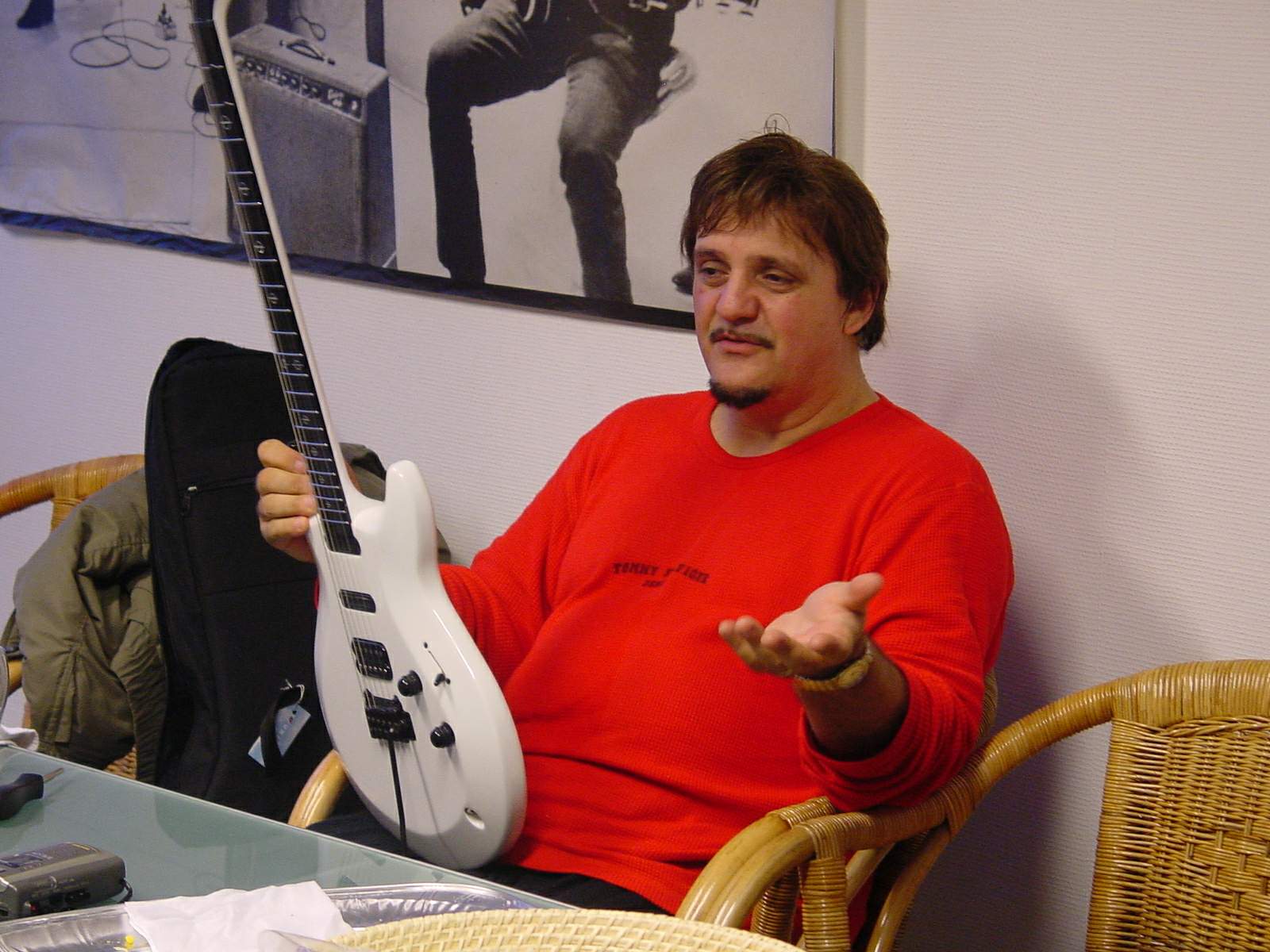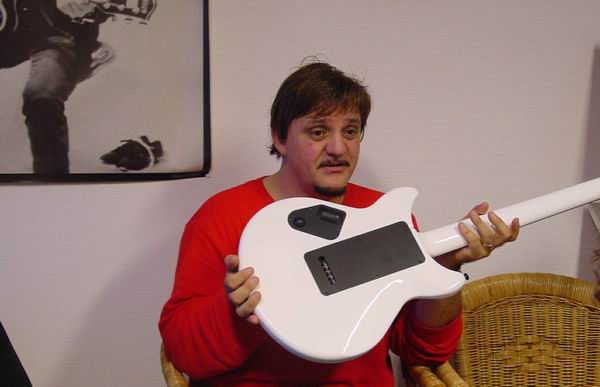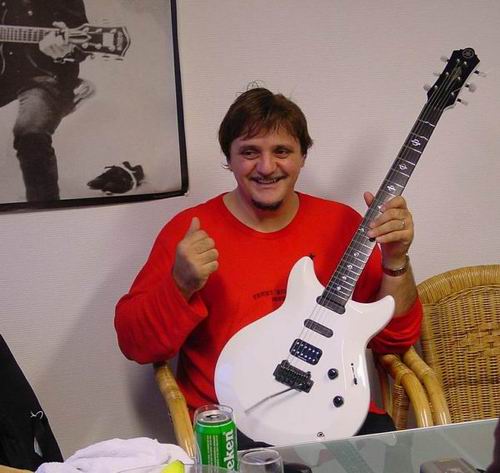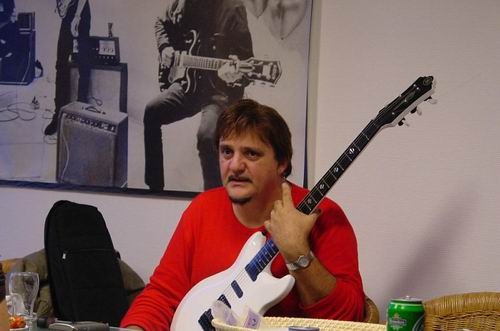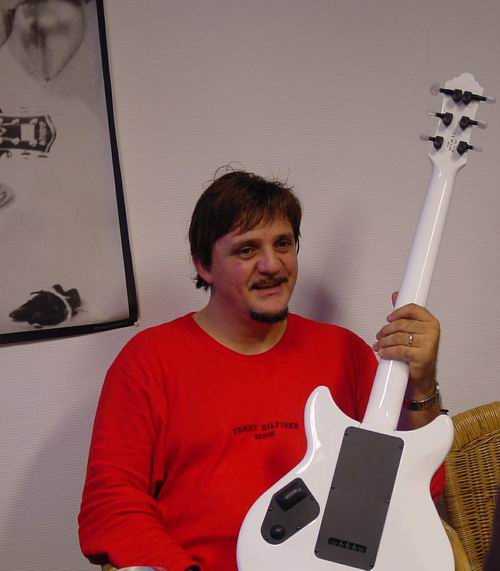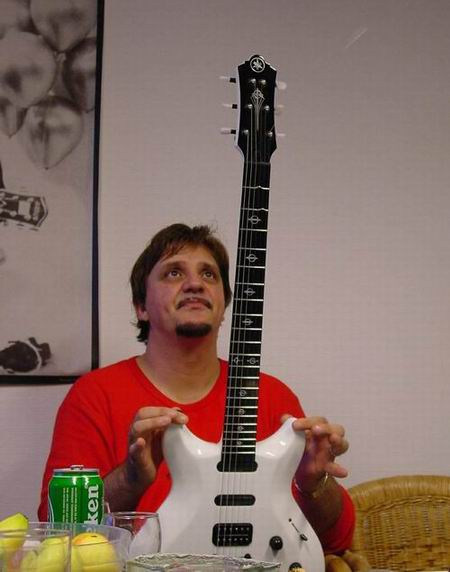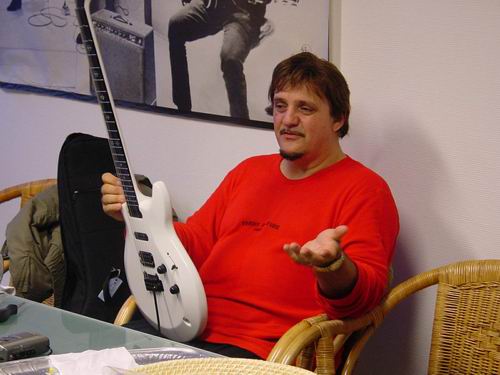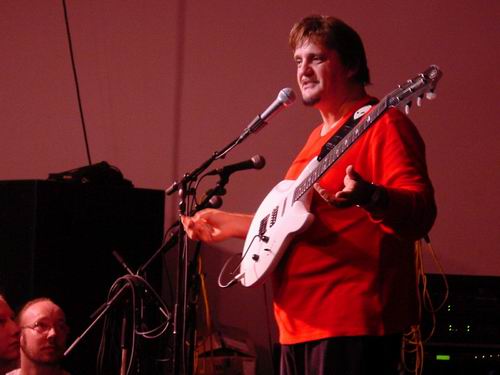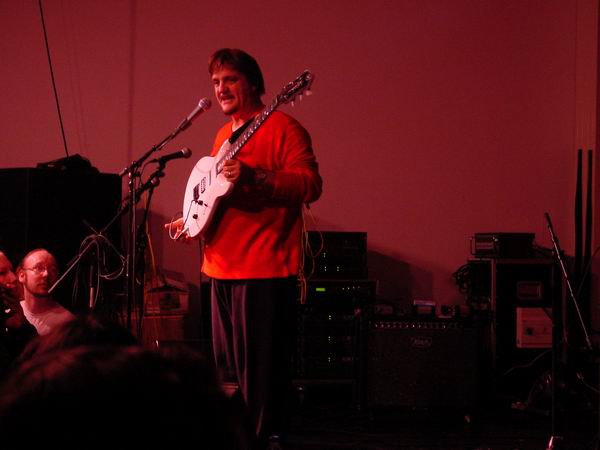At the European Guitar Event, 29 november 2003 in Rosmalen, I spoke to a very relaxed Frank Gambale with a new guitar, new tuning and a new haircut. He had just performed three songs with a backing cd for a crowd of guitar fans. Frank was moving another step forward, musically and with his life and it seemed he was at a very comfortable stage where he tours the earth and plays his favorite music with his favorite musicians. This was actually our second conversation, I had done an interview with Frank a year before this (that I still have to put up on this site – if I ever manage to find the time to type it out). That first conversation from 2002 was printed in the Music Maker ‘guitar special issue’ over 4 pages. This interview below will be printed in a different version with some extras in the upcoming issue of Guitar Magazine.
:: Photos and text copyright Richard Hallebeek and Guitar Magazine 2005. Copying or use elsewhere striclty prohibited. You’ve read this so don’t do it. ::
‘(Frank) I remember we spoke to each other a while ago, where was that?’
:: Feedback Music, Rotterdam.
‘Right.’
::You actually played the same tunes there.
‘Yeah..’cause I don’t do these much anymore. And I just have the same cd (laughs). That play along cd.. I haven’t bothered to make another one.’
:: Last time we spoke about your approach to composition, what happened since then?
‘A couple of things.. well..I’ve done the new Chick Corea Electric Band album which will come out in about..april I guess. The album is called ‘To The Stars’ and.. it’s incredible. I’m a huge fan of Chick Corea. And to be playing with him again, and the last couple of years we’ve toured, and we’re touring more this coming year, to follow up the new music, new album, it’s just.. the best thing that can happen.’
:: Will there be a new Corea Electric Band album after this?
‘Well.. one step at a time you know, we’ll see what happens. Hopefully.. I will be certainly up to doing another one. But we’ll just see how this one goes first. There seems to be a lot of interest in the group again. We did a great summer festival tour this year, played incredible places. Some of the best venues on the planet. So it was really great fun. We’re already scheduled to do at least two months or more of touring next year. I’m doing my next album right after I get back from this event. Billy Cobham is playing drums and a guy called Steve Billman is playing bass. It’s gonna be trio mostly. I’ve invented a new guitar tuning.’
:: I’ve heard about that.
‘I haven’t really told anybody what it is, yet. But I’m very excited about it and in fact I got Yamaha making me a double neck guitar which will be ready when I get back. I don’t like the idea of having to play two necks. But it may be where I’m heading for a while. To see if it’s something that’s..gonna stick. (laughs) But I love it, because I’m finally able to play keyboard closed voicings easily, comfortably and it’s just�the last couple of months I’ve really started to explore the possiblities. There is no chord I haven’t been able to play that I have desired to play. Not only is there no chord I can’t play, I can play these chords that I wanna play in every key. It’s not just one place with an open string or.. I can play these voicings in every key, all over the place. And it’s excilerating to my ear. So I’m hearing things that I haven’t heard in terms of harmony coming out of a guitar.’
:: You use it exclusively for chords, or for soloing too?
‘Chord melodies mostly. I think the reason this happened is because I have been playing trio. Playing trio is very demanding for a guitar player I think. I did it for years back in Australia and when I got to the States I mostly played with saxophone players and keyboard players. Mostly because I was frustrated with the chord dimension of guitar. The chord dimension on guitar to me.. was limited. There were a lot of people playing chord melodies. But it seemed limited. The voicings were spread out so it was comfortable on guitar and there’s a certain way you could play it.’
:: Like Holdsworth with those really wide stretches.
‘Oh! I just don’t wanna break my hands trying to play those crazy voicings all the time. I can’t play them smoothly from one to another. So what I did was, I put that stuff aside. And developed more of the single note-stuff, like sweeping. And transfer all my harmonic stuff, or a lot of it, onto keyboards. ‘Cause I play piano too, and I love piano. And I write a lot on the piano. There is no limit to the possibilities of notes on a piano. You can play with an elbow, you know (laughs) You can play all the notes, whatever you wanna do. And I just thought the guitar was beyond that capability. Until, recently I started thinking about some other possibilities with tuning. Eventually I’m gonna tell people what it is. I’m not gonna tell anybody ’till I’ve recorded it. And judge the reaction from this next record. ‘
:: So is it a drastic thing where bass strings are removed?
‘Actually, with everybody going down, it’s interesting to me, ’cause I’ve gone up. My lowest string is an A. I let the bass player play the darn bass, I don’t wanna go (imitates chunky low riff on a guitar) that stuff is ridiculous. You play guitar down that low, what’s the bassplayer gonna do? Go down another octave?’
:: Well, in a bandformat it’s best to my ears avoiding the low strings in most situations when playing chords anyway.
‘Oh yeah. That’s right. So that’s why I went up instead. The beatiful thing is you can play regular chord voicings as if it was a normal guitar. So that gives you a clue. That’s what beautiful about it. If you wanna play it like a normal guitar, you can. So I’m developing that, I’m gonna record it on the new record, it’s not all gonna be with that tuning. But about half the record will be.’
:: Will it be out on Tone Center?
‘Yeah.’
:: Same style as the other Tone Center stuff, kind of jam stuff?
‘No, it’s more composed this time. All my tunes. It’s not GHS 3. This is my stuff and it’s all composed. But it’s very guitary. Very guita,r chord melody kind of thing. It’ll have solos and stuff you know.I might double some parts, or comp. For myself, you know.’
:: You like to record your solos live with the band, right?
‘Yes. Well, that’s why I needed the double neck. To do it, I need to be able to switch between guitars quickly.’
:: Or put a guitar on a stand.
‘That was the other possiblity but I didn’t really wanna do that. As soon as I get back home, the guitar will be ready. I’m excited. I’m signing for two records with Mike Varney. I’m excited about using Cobham as well. I love the sound of this guitar now with that new tuning. What’s interesting is.. I played that tuning for Chick, I put some headphones on his head and said, hey check this out. And he’s going ‘hmm ah yeah..sounds good’ NO major reaction.. I mean, don’t you understand what’s going on here? (laughs) What you just heard doesn’t happen on the guitar! But for a piano player it makes no difference. He’s just going ‘that’s cool, that’s cool..’ So it’s really only gonna to be one of these subtle things that guitar players.. if they try and play what I play they’re gonna realize that hey, hang on.. there’s something going on here!’
:: I’m doing a lot of alternate chord stuff on the VG-88, that is a very inspiring tool.
‘Actually, the VG-8 is what got me started on this idea. I was playing with the VG-8 as well. It’s about time the guitar.. I think the guitar is still evolving. I think it’s catching up fast to other instruments. We’ve had a 200 year-longer history of piano. It only stands to reason that there is some incredible harmonic piano music out there. But for guitar..there’s some great guitar music also but there’s always been the limitation of the instrument. And so I think this is making a little bit of a leap forward for the instrument.’
:: There’s a lot of good stuff going on recently like the Buzzy Feiten tuning or the Fretwave system, making the instrument more in tune.
‘Yeah, that’s great stuff.’
:: Are you still happy with your Yamaha signature guitar?
‘Yes, I still like it the way it is. The problem that Yamaha are having at this point in time is the guitar market. It’s a very traditional market. It’s almost like nobody wants anything new! To me that’s so wrong (laughs) I love Les Pauls, I play Les Pauls too. I play strats too, but you know..Les Paul, Strat, maybe a PRS. C’mon, there’s more. We don’t drive cars from the 1950’s, we keep moving forward and hopefully improving. A lot of great technology is going into guitars as well, you know.’
:: I know some guitar builders complaining about the same thing; the only assignments they get is building a ‘super’strat or something along those lines. They just don’t get the chance to build something different. But of course, most guitarplayers either wanna sound like Jimi Hendrix or SRV…
‘Well, not me! That’s for darn sure.I don’t wanna sound like anobody. I don’t wanna be anywhere near those players. Never will, never want to be. Somebody’s got to do it! Otherwise nothing changes. That’s why I’m alive. Whether I’m succesfull at it or not, is another story, but I wanna try to do something. I’m just not happy with any other approach, you know. I’m very excited about this new tuning. I don’t know if anybody else will be..but I am (laughs) I like to be able to play keyboardvoicings on a guitar. Not that it’s a keyboard voicing, to me it just harmony. It’s just that keyboard players have had the fortunate natural instrument where this harmony is so easy for them. And for guitar it’s always been a bloody struggle. I hear these chords, I wanna play them, and I’m not gonna go like this [makes wide stretch with left hand] to play it. But now.. I don’t have to. In fact, the squarest voicings sound the hippest. It’s incredible. Let me give you a little demonstration..[takes Yamaha steel string silent guitar out of bag, puts headphones on my head and strums some chords on the guitar] Isn’t that beautiful? ‘
:: Very cool! Sounds like you were playing some incredible wide shapes there.
‘You can tell! Cause you’re a guitar player. Most guys don’t..well.. it’s gonna be interesting to see what people think. I can’t get over the richness of the harmony, the potential..coming out of a guitar.’
:: Then you have a new amp coming out soon.
‘It’s coming out at NAMM. I forgot to mention it. Thanks for reminding me (laughs) It’s a no-tubes, solid-state preamp.’
:: A digital amp where you can store your sounds?
‘Yeah, it’s gonna be presettable, you know. Midi presets. It’s got effects built in as well. It’s got two mid range filters.’
:: Like low-mid and high-mid?
‘You can set the frequency. It’s kinda like a mid range..parametric. Because that’s where the guitar is, mostly. In the mids. ‘
:: That’s what I like about the Yamaha amps, those two mid range knobs.
‘I like that too, yeah. I like that as well, but I like the be able to set the frequency. And then set the width of the band. So, that’s come out pretty well. I think there’ll be a later version of it too, they just wanna get it out now, but..’
:: There’s gonna be a version II software update later.
‘Probably, yeah.’
:: An updatable amp.
‘Exactly. It sounds pretty darn good.’
:: What speakers do you use with it?
‘I use Carvin.. I’m really getting into the Carvin gear. I use their 2 x 12″ open back cabs.’
:: No 4 x 12″s anymore for you?
‘I’ve used 4 x 12″‘s for years, Marshall’s and all that stuff, but.. there’s something about these 2 x 12″ open backs cabs, they sound..sweet. They’re a little softer, not as harder edged. 4 x 12″ cabs are great, but there’s something friendlier about these 2 x 12″ speakers, I use two of them.’
:: I saw Scott Henderson play two smaller cabinets a while ago.
‘I don’t know he did it as well, that’s interesting. He’s always had a great sound. I don’t know if my sound has ever been as good as his (laughs) but.. a lot of people were saying ‘you’re gonna make a preamp without tubes, are you crazy?’ But look how many of these Line 6’s, those little POD’s, have sold. Not a tube inside.’
:: You prefer Yamaha modeling over Line 6?
‘Generally speaking, yes. But I think they’re an innovative company and I think they’ve got some good ideas, you know.’
:: They have some aggressive marketing, too. You cannot open a magazine anymore without seeing their name on at least four different pages.
‘Yeah. And they’ve sold millions of those POD’s. People, you know.. what can you expect from a little thing like that? Is it really a 4 x 12″ Marshall, is it really a blackface Fender? No. No it’s not (laughs) But people like that. If they see it written, they think it is. So, it’s a psychological game they’re playing.’
:: There’s even all the pictures in the manual of the original amps they’ve modeled. I still don’t know how they get away with that.
‘Really? Oh, that’s nasty. Isn’t that interesting. Well, I know some people that work for their company and they’re.. innovative people. But so, that’s my argument when people say ‘there’s no tubes?’ The guitar industry is like the last industry on the planet that still uses tubes. There’s a couple of factory’s left in China. And I don’t want to be dependent on tubes. Tubes sound great , but they deteriorate quickly, you gotta change them, they get damaged, you’re never sure of the quality of them, they’re expensive, So I thought, why don’t we try to make a great sounding preamp that doesn’t have any tubes. The maintenance issue will be zero. I think we’ve done a pretty good job. ‘
:: You can get a good sound at any volume probably.
‘Yeah. The clean sounds are especially good on this machine. So I’m gonna have a set of presets, so that people can turn it on.. you know I really was using the Marshall preamp for a long time, the JMP-1. I wanted it to be better than this. My only critisism of the Marshall was that the equalisation is useless. Really, there’s three trebles and a bass, is what you got with Marshalls (laughs) Doesn’t matter if it says ‘midrange’, ‘treble’ or ‘presence’ it’s all just highs and never enough lows. That’s why I wanted to have better equalisation for sure and that’s why we have the two midrange frequency sweeps. And we took my favorite presets on the marshall and I went, I wanna get as close to this as possible. We’ve looked at it on a scope and I said I want to have the basic tone, same as this, but I want everything to be level. So, everything at zero is gonna sound very close to a really great guitar sound. And then you can make minor adjustments. Or radical adjustments if you want. I remember getting the sound I wanted out of a Marshall but had to make radical adjustments. I wanted it to be like that right out of the box, you just turn it on and hey, it sounds good. And it’s handy having effects built in as well. Good delay and chorus.’
:: So you don’t bring your TC G-force anymore?
‘No, I didn’t bring anything today. It was hard to hear me anyway (the European guitar contest was very noisy from the demonstrationds at the different booth’s -rich) There’s no possibilities of subtle things in a show like this.’
:: After making music for all these years, what keeps you inspired?
‘Oh, I went to the Van Gogh museum yesterday in Amsterdam. Things like that keep me inspired. Art keeps me inspired.’
:: What kind of art are you into?
‘I’m a big surrealist fan. Must have been the mushrooms I ate when I was younger (laughs) ‘
:: Australian mushrooms?
‘They’re quite notorious! (laughs) Of course I don’t do them anymore, it’s been twenty, thirty years or something since, but..I think those surrealist painters, especially Dali, Mc greed and all those guys must have been doing something strange! To have that perspective. And I just love the eccentricity of those guys. Dali in particular, such an eccentric and a genius. One of his books.. I love this book..(..grabs book from bag] Check this out. Fifty secrets of magic craftsmanship. This book is written by Dali, and..very few people would have the balls to do what he did in this book. He gets pissed of with art in the day and he’s looking all these other artists that are popular and he’s going ‘these guys suck’. He has this chart, look. He even decided to make a chart of all these other painters and he gives them a grade (laughs) based on craftsmanship, inspiration, colour, design, genius, composition, originality, mystery..these are some of the famous painters that were around at the time. ‘
:: He doesn’t like mondriaan too much..all zero’s..
‘Don’t you think that’s incredible though? I mean, you can’t argue with the guy because he’s a genius. He may be arrogant, he may be pigheaded, BUT.. you can’t argue that he’s not a brilliant painter. So a person in that position is qualified to have an opinion. And it’s a very important opinion of other painters at the time. I was inspired by that. I wrote a letter to guitar player magazine and said:’you know what? I get Guitar Player Magazine, it comes through my mailbox every month. And they have so much shit on the cover.. that I’m fed up with it. Isn’t anybody else fed up with it?’
:: I am.
‘Isn’t anybody gonna say something? I think the last straw for me was when they had White Stripes on the fucking cover. I mean, what a bunch of hopeless musicians. I mean, I don’t care if they’re on top or number one, somebody has to say that that’s crap. You know, in terms of musician ship..I’m not saying that this stuff shouldn’t exist. It all will exist. But there’s no balance. When was the last time they had a guitar player on the cover that was.. a guitar player’s guitar player?’
:: I quite reading that stuff around ’94.
‘I wanna do a controversial article. I said: ‘ I wanna be on the cover of your magazine again, the last time I was on the cover was 1988 ‘. I’ve done a lot of stuff since then. Most of which has been completely unnoticed by your stupid magazine’ (laughs) So, why?’
:: Money.
‘But are people who sell the most records the best? I’m just fed up with it, you know. I don’t mind being the controversial figure, I don’t mind saying it, because nobody’s gonna argue that I can’t play the guitar. I’m a qualified guitar player. Qualified to have a good opinion, about guitar.’
:: Any reply from them yet?
‘Yeah, they were interested. I said, I don’t mind telling it like it is, it’s make some energy happening at your magazine. The controversy is ok. I don’t care if people resent me for it. You look at Dali, 30 or 40 years after he dies and his art lives on. You won’t see the equivalent of Limp Bizkit in 25 years from not. Nobody will give a shit. And so, let’s just look at it the way it is, you know. Give credit where credit’s due. What happened to art ? Nobody cares anymore, nobody wants to push the boundaries. I get frustrated with it.’
:: You’re teaching at LAMA. Do you notice the same tendency there with the new guitar players coming in?
‘Well, this is part of my energy in my life, is to teach music the way I see it as well. LAMA is my labour of love. Trying to teach music the way I see it. It’s not only my curriculum, but I would say about 80% of the curriculum is my work. I let the other teachers also have their contribution and.. the school is going very well. I mean, this is a serious music school, you wanna go and learn to play guitar, hopefully people would choose our school as one of the serious places to go. Our reputation is growing, I’m there whenever I can be, about 6 months of the year I’m usually there. I teach one full day a week, when I’m there. A 10 or 12 hour day. ‘
:: What do you teach?
‘I teach my improvisation course, I teach my harmony and theory and a modal class. Modal playing. That’s my main subjects. And then I do some of the ensemble classes where the students are playing and I critique them. It’s fun to just listen to them play and go..you need a little bit of this, of that.. And I really see great progress in these kids, I just want them to understand music. It’s not just about playing guitar, it’s about understanding the music. That’s what we strive for, when they leave, if they have an understanding, it’s like the old proverb of we teach some of them to fish rather then feeding them, giving them the independance to do with music what they want and understand the music. Then they can be more creative.’
:: I have lots of your books and have to say you’re a really good teacher. You really know how to explain things in depth but still in an understandable way.
‘Well, thanks.’
:: More books?
‘I have a few projects that are pending.’
:: Will you ever release the LAMA curriculum?
‘Well..no, that’s exclusive to the school. Although I own it. But they pay me for it, basically, every student. So, I’m not about to publish it. But a lot of my instructional work goes into the school at this point of time. For example, I’m writing another course that we’re gonna include, so it occupies that part of me, but the world doesn’t get to see it at this time, ’cause I don’t publish the book. It’s just a curriculum addition for the school. But I am working on another speed picking book, which I’ve done already about one or two chapters of, but that’s been like that for two years now (laughs). I have another concept that I’m about half way through, for a very basic book about major scale harmony, but it’s..the thing I notice.. I get my ideas from my students really. I see where their problems are and I try and address those problems. I figure, if those kids are a bit of a cross-section of what’s probably out there in the real world.. kids you know, you give ’em their scale…here’s a major scale chord progression, all they do is play the scale and they don’t really know that some of the notes are in the chord and some of ’em are not in the chord. I teach them chord tones and passing tones. It’s coming down to basically two sounds, tension and resolution. In fact, that’s gonna be the name of the book. That’s what it’s all about. You gotta know what notes are in the chord, what notes are out of the chord.. gotta learn the ones in the chords first. You got seven notes in a scale, if you’re playing on a triad, only three of ’em are in the chord. So you have to know where they are in every position. I’m working on this idea. It’s a very simple idea, but it’s very neccesary to understand.’
:: You did the same thing with that modes video. A simple subject but explained in a different and more thorough way then most people would.
‘Well, I think what was important on that video was to get the concept that you need to understand intervallic structure of any scale.’
:: Compared to the major scale.
‘Yes. They’re all compared to that scale and they’re all the intervals within an octave. So it’s all just variations of a major scale. So if they see it that way, then the chord makes sense, too. Learning all the modes starting on the same note is the important thing. And then showing them how to make a modal chord progression. Based off the harmonized scale. Simple idea, but effective.’
:: ‘Improvisation Made Easier’ is also a simple idea, but a great method of learning how to play through changes.
‘The cool idea in that book, I thought, was including the chords. I find this with my students also, there’s a very big disconnection between the chord and the single line. For some reason, when guitar players are playing chords, you know, it’s pretty comfortable, they’ve got a few different voicings, soon as they go to a single line, they have no relation, they see the guitar in an entirely different way. Then the way they did when they were playing block chords. if can visualize the whole chord when they’re playing a single note, then they’ve got the chord tones. The notes of the chords are the solid tones, and so..it’s funny how they disconnect that. That’s what I try to bring back together a little bit in a modal sense with that book. You’ve got the scale, you’ve got the chords..from that scale that make that scale sound and then the line, the improvised line. Try to bring them together. ‘
:: Do you still have time to study guitar and work on new ideas?
‘Boy, am I! With this new tuning�I’ve got enough work to do with this tuning for a while.’
:: Single line stuff.
‘I’m still evolving that. I’m working on my time. That has become more and more important to me over the years. Getting better at time, in improvised situations and.. you know I’ve been playing with so many great drummers that it really helped a lot over the years. Play just perfectly with them in the subdivisions with them..’
:: How do you study time besides playing with a drumcomputer?
‘I always play with a sequencer, because it’s perfect time. Some people think sequencers are bad, I think it’s the best way to practise. ‘
::What set up do you use for that?
‘My regular recording setup. You just gotta work on all the subdivisions and then syncopation. It’s great fun to shift groupings. Like odd over even, where you take 16th notes in 4 at a time, 5 at a time, 3 at a time, 6 at a time, 7 at a time, patterns of 9, it really helps develop your 4/4 very well so that you can play syncopations without losing your place. It’s sort of a syncopated superimposition of the time. Drummers do it all the time. 16th notes.. there’s alot of possiblities and subdivisions. You have two bars, that’s 32 notes. There’s a million ways to divide it. And then you start leaving notes out. So if you do a group of five, you leave one note out. So the space in the phrase, that’s fun as well. And then you do the same thing with triplets. 8th notes triplets, you do them in groups of 4. Groups of 2, tuplets, or groups of 5. Five triplets is really bizar. (laughs) All sorts of rhythmic confusion you can create. And then try to write it into a line and song form, you know. That’s really the fun part, try to make music out of it. Ultimately, that’s what you wanna do. ‘
:: You brought a Yamaha silent guitar with you, do you actually use that live or in the studio, or is it just a composing tool?
‘I brought it along with me because I need to finish up some of the songs I’m writing and try to get all the music finished. It all sort of happened pretty suddenly, so luckily I had a couple of weeks at home, I was able to come up with a couple of reasonable songs.’
:: Is it hard finishing your song, or to push yourself to?
‘No, I find it.. that is a problem for a lot of people. I actually wrote a composition course for the school, too.I offer a lot of suggestions for finishing songs. In fact, it’s the first lesson in composition at the school. How difficult can it be to finish a composition? Think of it this way. You take a piece of music paper, this is the beginning and that’s the end, two pages. The most basic thing you can do is, look, let’s say the A-part is 16 bars. Block the bars at 16 bars. The B-section, maybe 8 bars. Then we’re gonna repeat A, let’s do a 4-bar introduction, 16 bars A and 8 bars bridge.. that can be enough for a composition. You might wanna have a second bridge, for example. Or a solo section. So you put in an 8 bar of 16 bar solo section, then maybe a coda. An 8-bar coda. If you begin with a finished form, then fill it in. Fill in the chords. Make your own chords. You don’t even need to hear the chords, just write chords in and then make a melody to fit those chords. That’s a completed composition. It might not sound good, but..
:: It’s a good way to push yourself to find something.
‘That’s right. I find for me, the best way to finish a composition is to do it on the sequencer. When I’ve got a good idea for a song, then I put that much on the sequencer. Then I’ll listen to it and try to imagine the next part. So then I create something to fill in the next part. Then I just cut and past and put stuff over here and there, transpose stuff, the transitions need to make sense, you know. Songs are songs. There’s a beginning, there’s the main theme, maybe a second theme and a coda. I mean, how many things do you need to write? It’s one way to do it.’
:: Copyright Richard Hallebeek and Guitar Magazine 2003 ::
